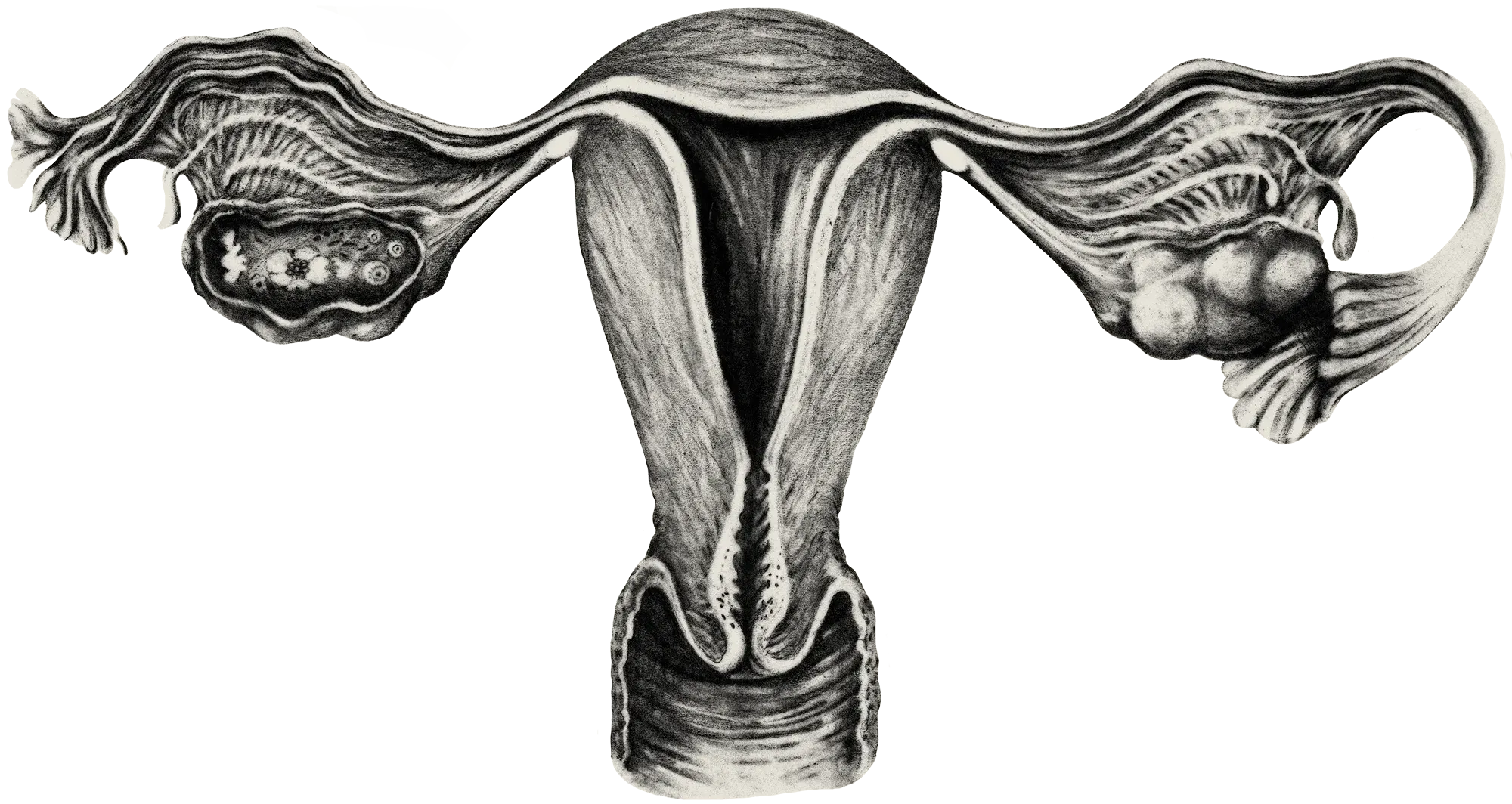Endometriosis
Potential of Panax ginseng and its bioactive constituents as a non-hormonal alternative for the alleviation of perimenopausal symptoms.

- Introduction
- Antiproliferative effects
- Restoration of autophagy
- Anti-angiogenic effect
- Conclusion
- Bibliographic references
-
Introduction
Long silenced and under-diagnosed, endometriosis is still a little-known pathology that has recently come to the forefront because of its high incidence among modern women.
Endometriosis is defined as a proliferation of endometrial tissue outside the uterine cavity. It generally causes significant gynecological pain (pelvic or abdominal, often chronic), painful menstruation and sexual intercourse, and even infertility in the most severe cases. It may also be asymptomatic and go undetected / undiagnosed for years in certain cases.
It is estimated that endometriosis affects about 10% of women of childbearing age and between 20 and 50% of patients suffering from chronic pelvic pain and / or infertility.
Ginseng has a long history of use and a significant number of health benefits supported by scientific studies. Among those benefits stand promising antitumor, antioxidant, immunomodulating and anti-inflammatory properties, all of which may positively influence the inflammatory state in the context of pathologies like endometriosis. Ginseng and its saponin compounds could therefore appear as a natural solution with great potential for inhibiting the physio-pathologies linked to endometriosis and ultimately help its resolution.
-
Antiproliferative effects
Several studies demonstrate that treatment with red ginseng saponin extracts - and the individual ginsenosides Rg3, PPD, PPT and Rh2 - significantly reduces the viability of human endometrial stromal cells (HESCs) from patients with endometriosis in a time- and dose-dependent manner.
Rg3 treatment also significantly reduces the proliferative (Ki67 marker) and invasive (MMP2, MMP9 markers) nature of HESCs and induces a reduction of fibrosis markers in-vitro as well as in-vivo.
The mechanism of this in-vitro pro-apoptotic effect of ginseng saponins, and in particular Rg3, on endometriosis cells would be notably linked to the modulation of the expression of microRNAs involved in the pathogenesis of the disease and is accompanied by an increase in the expression of caspase 3, a programmed cell death/pro-apoptotic enzyme. Modulation of these miRNAs could therefore constitute a new approach for the treatment of endometriosis.
In vivo, supplementation with ginsenoside Rg3 in a mouse model of endometriosis has been shown to significantly inhibit the size, growth and fibrotic nature of endometriotic lesions.
-
Restoration of autophagy
In addition to their increased proliferative (tumor-like) capacity and low apoptotic capacity, HESCs are characterized by a low level of autophagy.
Rg3 and PPD ginsenosides have been shown to down-regulate serum estradiol levels in rats, resulting in a significant inhibitory action on the development of endometriotic lesions. In particular, the anti-endometriosis activity of ginsenoside PPD relies on 3 mechanisms of suppression of autophagy inhibition mediated by estradiol mediated by autophagy-related proteins (CXCL12/CXCR4, Beclin-1, LC38).
The reduction of autophagy - and thus the efficient removal of ectopic endometriosis tissue - is furthermore involved in the impairment of NK cell cytotoxicity. PPD ginsenoside has been shown to have the potential to directly activate Natural Killer (NK) cells by treatment or indirectly in coculture with PPD-pre-treated ectopic HESCs. The mechanism is thought to be based on increased activation of natural cytotoxicity receptors.
Restoration of autophagic function of HESCs by Rg3 and PPD ginsenosides therefore also presents a therapeutic pathway of interest for the treatment of endometriosis.
-
Anti-angiogenic effect
The growth of fibrotic tissues (ectopic HESC) in endometriosis is accompanied by the generation of blood vessels (angiogenesis) from pre-existing networks. Blocking this process would therefore slow down the development/progression of the disease and promote apoptosis of ectopic HESCs.
Two mechanisms could be involved in the anti-angiogenic potential of ginsenoside Rg3 in the context of endometriosis: the NF-kB signaling pathway and the PI3K/Akt/mTOR signaling pathway.
The anti-angiogenic approach, widely used in oncology, would also have a high therapeutic potential in the treatment of endometriosis.
-
Conclusion
In conclusion, ginseng saponins - and their noble bioactive forms - demonstrate a multi-target action on various development factors of endometriosis as well as significant alleviation of its symptoms and potential risks for fertility.
Ginseng and its active compounds could therefore constitute an effective, natural, and non-hormonal alternative to improve the existing Nutraceutical offer in terms of women's health and well-being. A new applicative potential for ginseng that deserves further investigation to ensure safe and free of side effects in a clinical context.
-
Bibliographic references
[1] Park, J. H., Lee, S. K., Kim, M. K., Lee, J. H., Yun, B. H., Park, J. H., ... & Choi, Y. S. (2018) – “Saponin extracts induced apoptosis of endometrial cells from women with endometriosis through modulation of miR-21-5p.” Reproductive Sciences, 25(2), 292-301.
[2] Kim, M. K., Lee, S. K., Park, J. H., Lee, J. H., Yun, B. H., Park, J. H., ... & Choi, Y. S. (2017) – “Ginsenoside Rg3 decreases fibrotic and invasive nature of endometriosis by modulating miRNA-27b: in vitro and in vivo studies.” Scientific reports, 7(1), 1-14.
[3] Huang, R., Chen, S., Zhao, M., Li, Z., & Zhu, L. (2020) - “Ginsenoside Rg3 attenuates endometriosis by inhibiting the viability of human ectopic endometrial stromal cells through the nuclear factor-kappaB signaling pathway.” Journal of gynecology obstetrics and human reproduction, 49(1), 101642.
[4] Zhang, B., Zhou, W. J., Gu, C. J., Wu, K., Yang, H. L., Mei, J., ... & Li, M. Q. (2018) – “The ginsenoside PPD exerts anti-endometriosis effects by suppressing estrogen receptor-mediated inhibition of endometrial stromal cell autophagy and NK cell cytotoxicity.” Cell death & disease, 9(5), 1-13.
[5] Jie, Z. O. U., Zheng, G. U. A. N., Zhang, W. Y., Wei, X. I. A. O., & Ya-Li, L. I. (2013) – “Beneficial effects of the Chinese herbal medicine Sanjie Zhentong Capsule on experimental endometriosis in rats.” Chinese journal of natural medicines, 11(6), 666-672.
[6] Cao, Y., Ye, Q., Zhuang, M., Xie, S., Zhong, R., Cui, J., ... & Cao, L. (2017) – “Ginsenoside Rg3 inhibits angiogenesis in a rat model of endometriosis through the VEGFR-2-mediated PI3K/Akt/mTOR signaling pathway.” PloS one, 12(11), e0186520.
